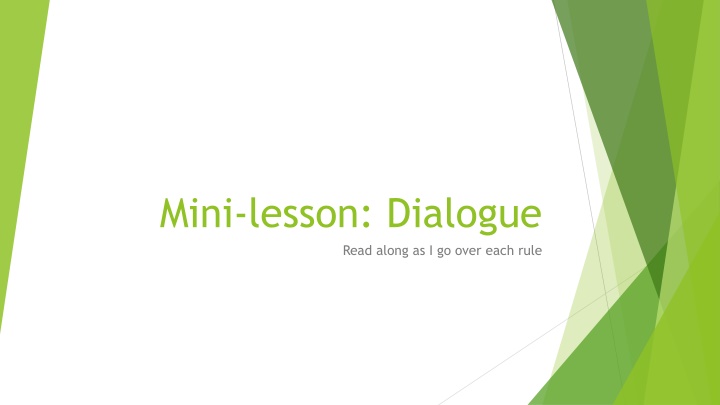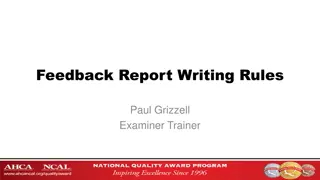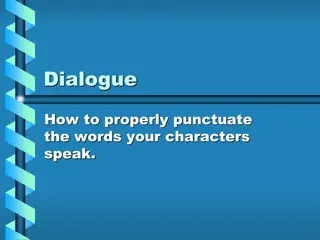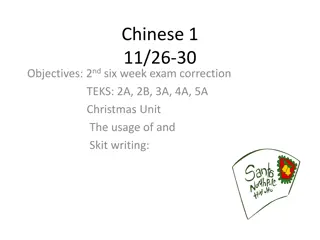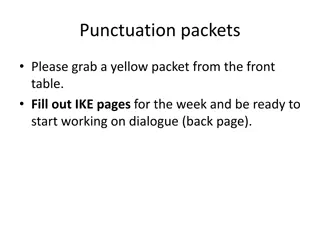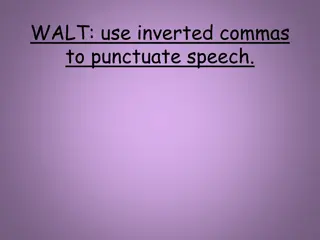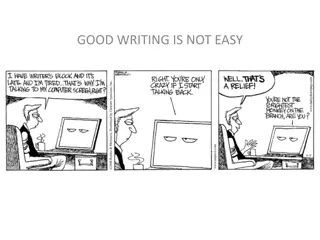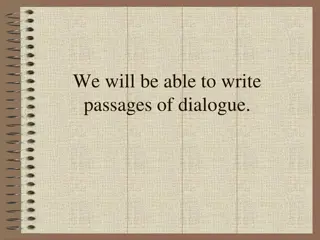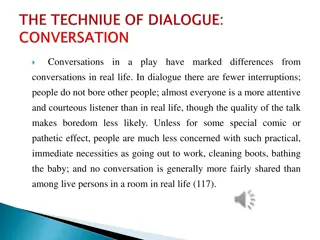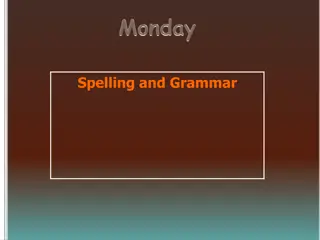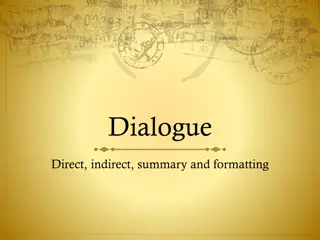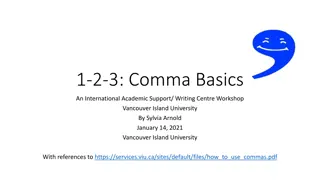Mastering Dialogue in Writing: Essential Rules and Examples
Learn the key rules of using dialogue in writing through examples and explanations. Discover when to use italics or quotation marks, how to handle punctuation and capitalization, when to introduce speakers, and how to add variety to dialogue tags. Get ready to enhance your writing with effective dialogue techniques!
Download Presentation

Please find below an Image/Link to download the presentation.
The content on the website is provided AS IS for your information and personal use only. It may not be sold, licensed, or shared on other websites without obtaining consent from the author.If you encounter any issues during the download, it is possible that the publisher has removed the file from their server.
You are allowed to download the files provided on this website for personal or commercial use, subject to the condition that they are used lawfully. All files are the property of their respective owners.
The content on the website is provided AS IS for your information and personal use only. It may not be sold, licensed, or shared on other websites without obtaining consent from the author.
E N D
Presentation Transcript
Mini-lesson: Dialogue Read along as I go over each rule
Example: Lea had always been my best friend. We had been through everything. But in that moment, everything we had been through didn t matter. Meghan was my sister. Even if she did cause Lea to lose Cupcake Wars, I couldn t believe she would insult my sister like that! Annoyed, I said, Hey! Cut it out! How do I indicate dialogue? Italics or quotation marks No way! She replied, still glaring at Meghan. Whenever a new person talks, you must begin a new paragraph and indent it. Stop, or I ll tell them everything! She turned to stare at me. You wouldn t, she whispered. Try me.
Example: Lea had always been my best friend. We had been through everything. But in that moment, everything we had been through didn t matter. Meghan was my sister. Even if she did cause Lea to lose Cupcake Wars, I couldn t believe she would insult my sister like that! Annoyed, I said, Hey! Cut it out! What do I do about punctuation and capitalization? If you use a leading word like said or shouted , that word should be followed by a comma before starting your dialogue No way! she replied, still glaring at Meghan. The letter after a quotation mark is ALWAYS capitalized. Stop, or I ll tell them everything! She turned to stare at me. If you use a comma to transition out of a quote, you don t have to capitalize the next letter. You wouldn t, she whispered. If you use a question mark or exclamation mark, you do not need to capitalize the next letter. Try me.
Example: Lea had always been my best friend. We had been through everything. But in that moment, everything we had been through didn t matter. Meghan was my sister. Even if she did cause Lea to lose Cupcake Wars, I couldn t believe she would insult my sister like that! Annoyed, I said, Hey! Cut it out! Do I always need to introduce who s speaking? You don t always need to introduce who s talking if it is made obvious before hand. No way! She replied, still glaring at Meghan. Stop, or I ll tell them everything! She turned to stare at me. You wouldn t, she whispered. Try me.
Example: Lea had always been my best friend. We had been through everything. But in that moment, everything we had been through didn t matter. Meghan was my sister. Even if she did cause Lea to lose Cupcake Wars, I couldn t believe she would insult my sister like that! Annoyed, I said, Hey! Cut it out! I feel like I m saying said too much! Using the word said should definitely be part of dialogue, but using other words to make your dialogue more dynamic is encouraged. No way! She replied, still glaring at Meghan. Stop, or I ll tell them everything! She turned to stare at me. You wouldn t, she whispered. Try me.
Questions about Dialogue? If it s a general question, please ask now! If it s a question that s really just specific to your writing, please ask me as everyone is writing.
